文 章 目 錄
- 一、文 件
- 1、基 礎 知 識
- 2、C 文 件 接 口
- (1)代 碼 示 例
- (2)當 前 路 徑
- (3)文 件 權 限
- (4)w
- (5)a
- (6)三 個 輸 入 輸 出 流
- 3、分 開 顯 示 stdout 和 stderr
- 4、基 礎 知 識
- (1)open
- (2)close
- (3)write
- (4)標 志 位 傳 遞 方 式
- 二、訪 問 文 件 的 本 質
- 1、struct file
- 2、FILE
- 3、close(1)
- 4、fd
- 5、read
- 6、引 用 計 數 與 關 閉 文 件
- 三、重 定 向
- 1、文 件 描 述 符 的 分 配 規 則
- (1)原 版 代 碼
- (2)close(0)
- (3)close(1)
- (4)close(2)
- (5)總 結
- 2、重 定 向 的 原 理
- 3、dup2
- 4、輸 入 重 定 向
- 5、追 加 重 定 向
- 6、輸 入 重 定 向
- 7、printf 與 fprintf
- 四、總 結
💻作 者 簡 介:曾 與 你 一 樣 迷 茫,現 以 經 驗 助 你 入 門 Linux。
💡個 人 主 頁:@笑口常開xpr 的 個 人 主 頁
📚系 列 專 欄:Linux 探 索 之 旅:從 命 令 行 到 系 統 內 核
?代 碼 趣 語:當 0、1、2 先 占 滿 文 件 描 述 符 的 “插 槽”,open 總 會 尋 著 最 小 的 空 缺 安 家 - - - 每 個 fd 的 數 字,都 是 進 程 與 文 件 牽 手 的 “門 牌 號 碼”,藏 著 讀 寫 消 息 的 去 向。
💪代 碼 千 行,始 于 堅 持,每 日 敲 碼,進 階 編 程 之 路。
📦gitee 鏈 接:gitee

?????????Linux 初 學 者 常 困 惑:會 用 > 重 定 向 卻 不 懂 原 理,知 道 printf 輸 出 卻 不 明 其 與 “文 件” 的 關 聯,對 0、1、2 文 件 描 述 符 更 是 茫 然。這 些 疑 問 的 核 心,正 是 “進 程 與 文 件 的 交 互 邏 輯” - - - 本 文 以 實 操 + 原 理 為 核 心,從 “文 件 = 內 容 + 屬 性” 切 入,講 清 C 庫 / 系 統 調 用 用 法,拆 解 文 件 描 述 符 規 則 與 重 定 向 本 質,搭 配 代 碼 截 圖 幫 你 打 通 “命 令 - 代 碼 - 內 核” 鏈 路。
一、文 件
1、基 礎 知 識
文 件 = 內 容 + 屬 性- 文 件 分 為 打 開 的 文 件 和 沒 有 打 開 的 文 件。進 程 打 開 的 文 件,沒 打 開 的 文 件 存 儲 在 磁 盤 上,沒 有 打 開 的 文 件 非 常 多。本 質 上 是 研 究 進 程 和 文 件 的 關 系,要 快 速 的 對 文 件 進 行 增 刪 查 改。
- 文 件 想 要 被 打 開 首 先 應 該 被 加 載 到 內 存。
- 進 程 :打 開 文 件 = 1:n,一 個 進 程 可 以 打 開 多 個 文 件。操 作 系 統 內 部 一 定 存 在 大 量 的 被 打 開 的 文 件。操 作 系 統 要 管 理 被 打 開 的 文 件,先 描 述,再 組 織。
- 在 Linux 內 核 中,一 個 被 打 開 的 文 件 都 必 須 有 自 己 的 文 件 打 開 對 象,包 含 文 件 的 很 多 屬 性。
2、C 文 件 接 口
C 語 言 文 件 操 作
(1)代 碼 示 例
#include<stdio.h>
#include<unistd.h>
int main()
{printf("pid:%d\n",getpid());//打開文件的路徑和文件名,默認在當前路徑下創建一個文件FILE* pf = fopen("test.txt","w");if(pf == NULL){perror("fopen fail");return 1;}fclose(pf);sleep(100);return 0;
}

(2)當 前 路 徑
?????????當 前 路 徑 指 的 是 進 程 的 當 前 路 徑 cwd,如 果 更 改 了 當 前 進 程 的 cwd,就 可 以 把 文 件 新 建 到 其 他 目 錄。
?????????可 以 使 用 ll /proc/進 程 的 PID 來 查 看 進 程 的 當 前 路 徑。

chdir
更 改 進 程 的 工 作 目 錄。
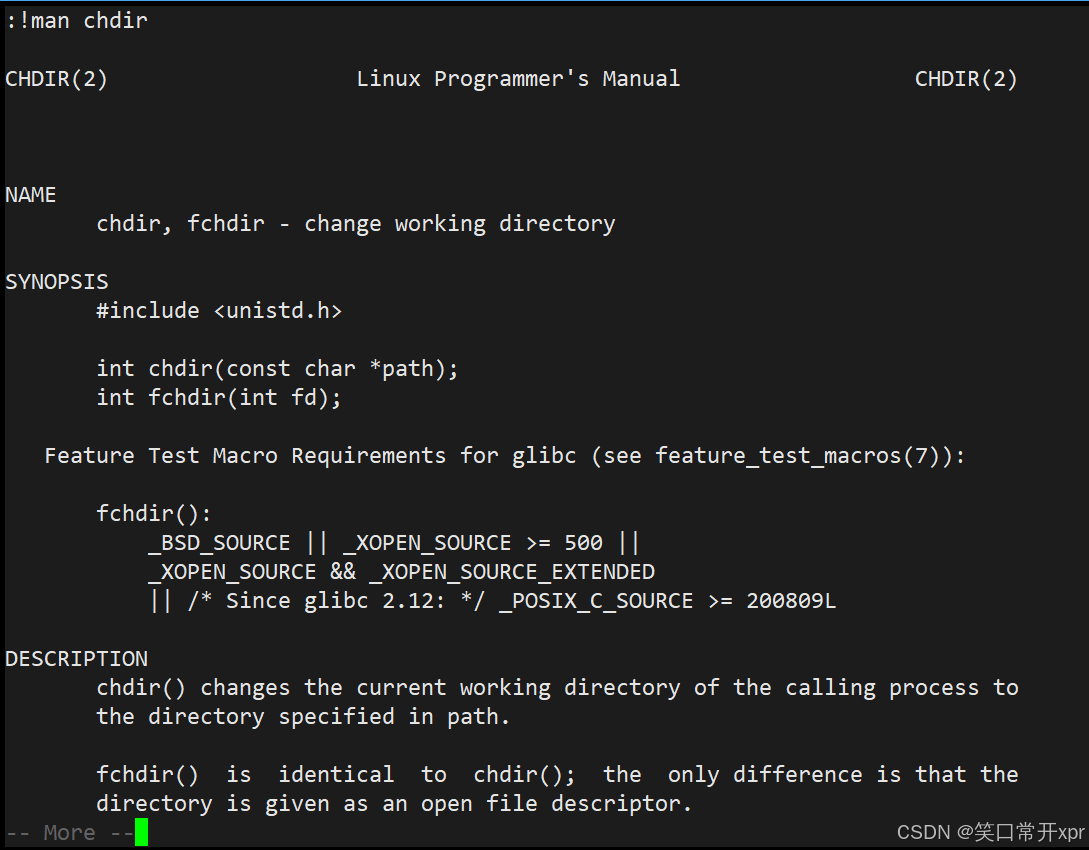
?????????在 上 面 的 代 碼 中 添 加 chdir("/home/xpr/linux"); 可 以 更 改 進 程 的 路 徑。

(3)文 件 權 限
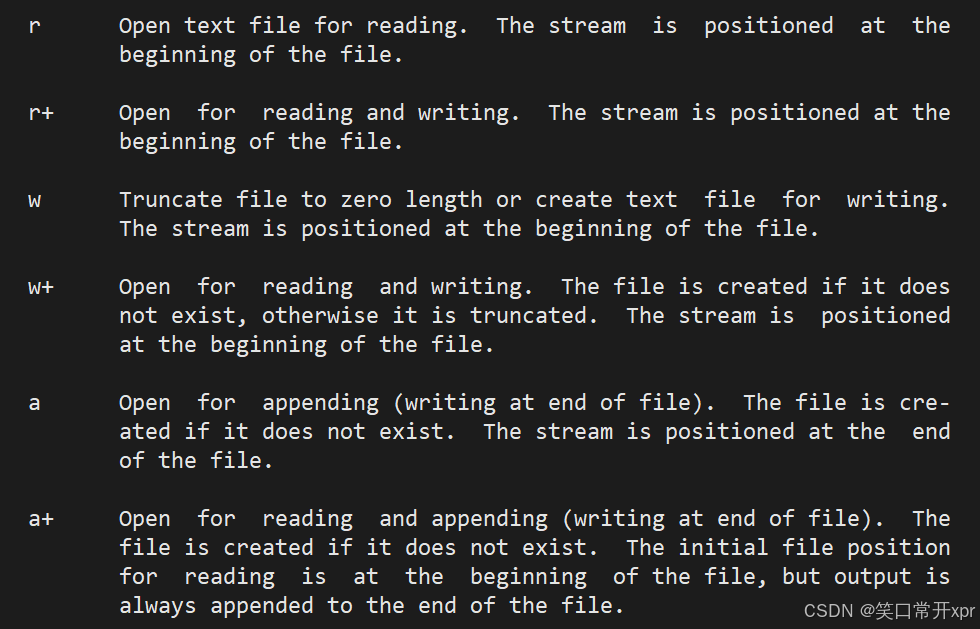
(4)w
?????????將 字 符 寫 入 文 件。如 果 沒 有 文 件 則 會 創 建 文 件,如 果 文 件 有 內 容 則 會 清 空。
fwrite
將 字 符 寫 入 到 文 件 中。
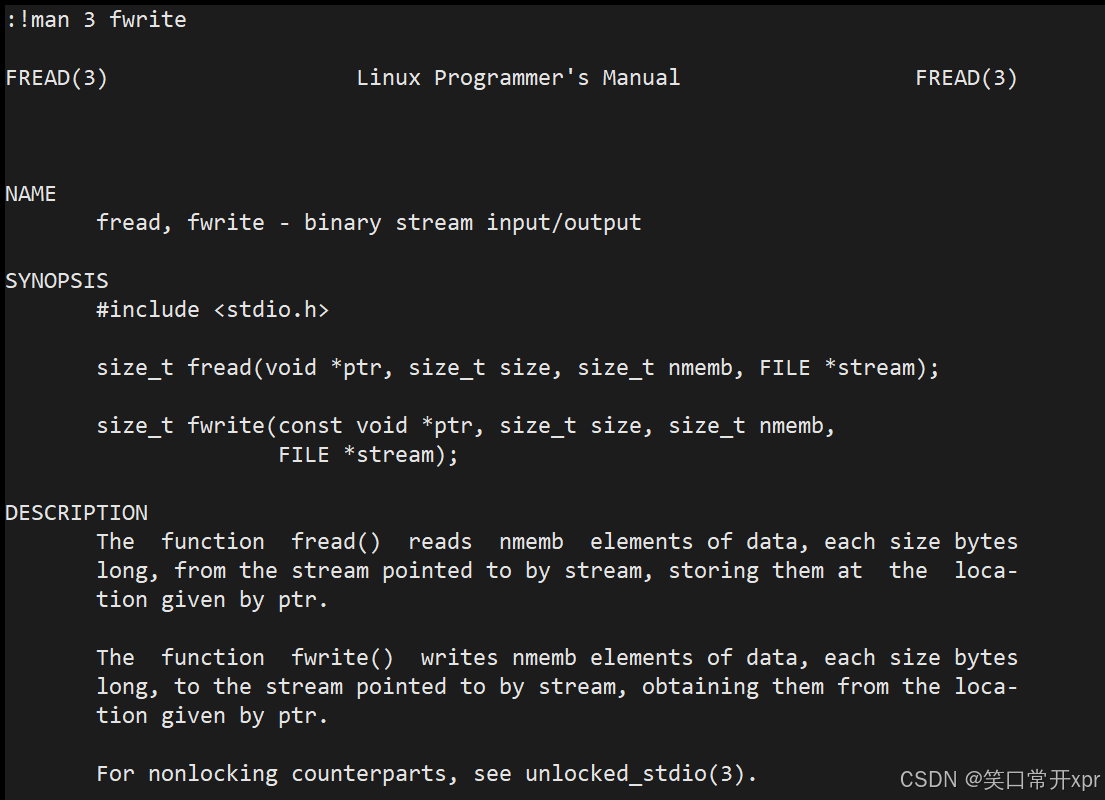
#include<stdio.h>
#include<unistd.h>
#include<string.h>
int main()
{printf("pid:%d\n",getpid());//打開文件的路徑和文件名,默認在當前路徑下創建一個文件FILE* pf = fopen("test.txt","w");if(pf == NULL){perror("fopen fail");return 1;}const char* str = "hello linux";fwrite(str,strlen(str),1,pf);fclose(pf);return 0;
}
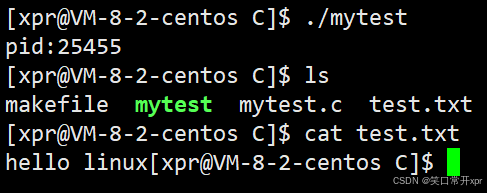
?????????這 里 strlen 不 需 要 加 1 原 因 是 因 為 如 果 加 1 會 出 現 亂 碼,如 下 圖 所 示。字 符 串 以 \0 結 尾 是 C 語 言 的 規 定,和 文 件 沒 有 關 系。
strlen + 1
strlen + 1 會 在 文 件 中 出 現 ^@,這 個 字 符 就 是 \0。

echo 及 輸 入 重 定 向
?????????類 似 的,echo 的 輸 入 重 定 向 和 w 類 似,如 果 沒 有 文 件 則 會 創 建,文 件 有 內 容 則 會 清 空。

(5)a
?????????在 文 件 結 尾 追 加 字 符 串,如 果 沒 有 文 件 則 會 創 建 文 件。

#include<stdio.h>
#include<unistd.h>
#include<string.h>
int main()
{printf("pid:%d\n",getpid());//打開文件的路徑和文件名,默認在當前路徑下創建一個文件FILE* pf = fopen("test.txt","a");if(pf == NULL){perror("fopen fail");return 1;}const char* str = "hello linux";fwrite(str,strlen(str)+1,1,pf);fclose(pf);return 0;
}
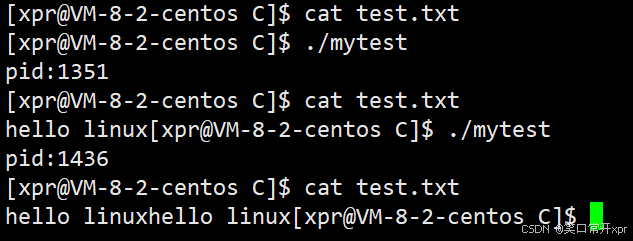
echo 及 輸 出 重 定 向
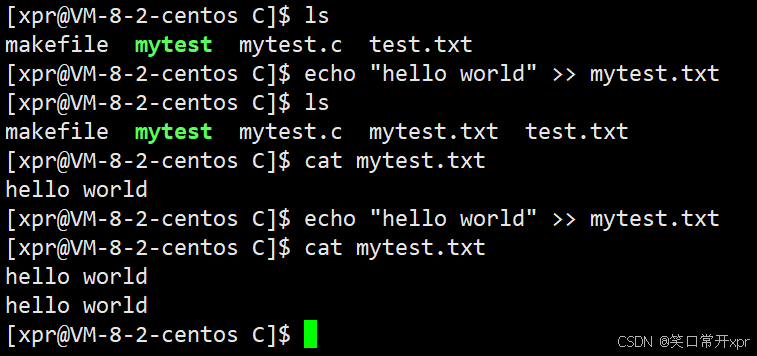
(6)三 個 輸 入 輸 出 流
?????????所 有 的 語 言 在 啟 動 時 默 認 都 會 打 開 對 應 的 設 備 文 件,原 因 是 因 為 電 腦 開 機 時 就 會 打 開 顯 示 器 和 鍵 盤,編 寫 代 碼 時 使 用 鍵 盤 輸 入,用 顯 示 器 顯 示。C 語 言 的 3 個 輸 入 輸 出 流。C 程 序 默 認 在 啟 動 時 會 打 開 三 個 標 準 輸 入 輸 出 流(文 件)。
所 有 的 語 言 對 于 文 件 的 操 作 都 包 括 文 件 描 述 符 fd
stdin:鍵 盤
stdout:顯 示 器 文 件
stderr:顯 示 器 文 件
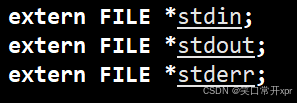
3、分 開 顯 示 stdout 和 stderr
#include<stdio.h>
#include<unistd.h>
#include<string.h>
#include<sys/types.h>
#include<sys/stat.h>
#include<fcntl.h>
#define filename "log.txt"
int main()
{fprintf(stdout,"hello normal message\n");fprintf(stdout,"hello normal message\n");fprintf(stdout,"hello normal message\n");fprintf(stdout,"hello normal message\n");fprintf(stderr,"hello error message\n");fprintf(stderr,"hello error message\n");fprintf(stderr,"hello error message\n");fprintf(stderr,"hello error message\n");return 0;
}
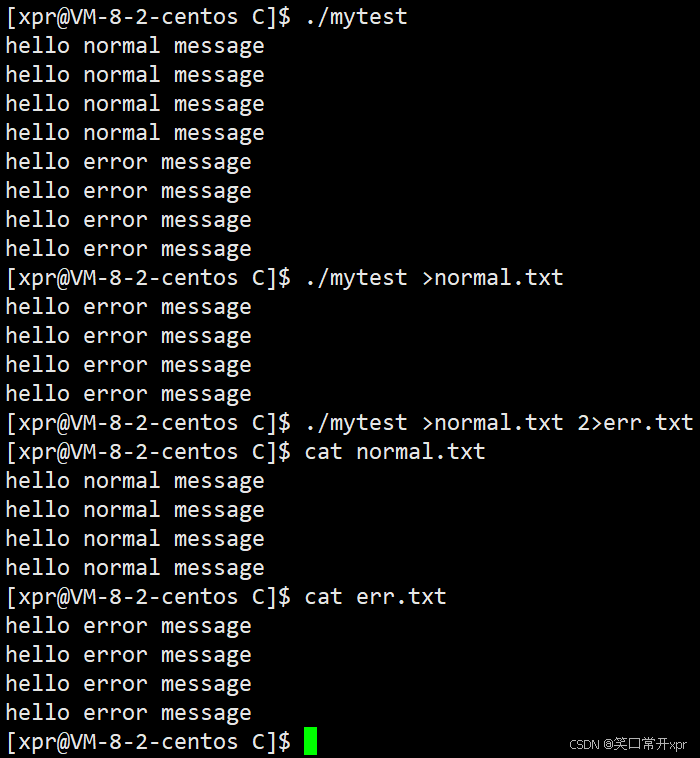
?????????重 定 向 以 后,向 1 里 面 寫 入 的 內 容 都 會 寫 入 normal.txt 文 件 中。只 對 1 重 定 向,沒 有 對 2 重 定 向。
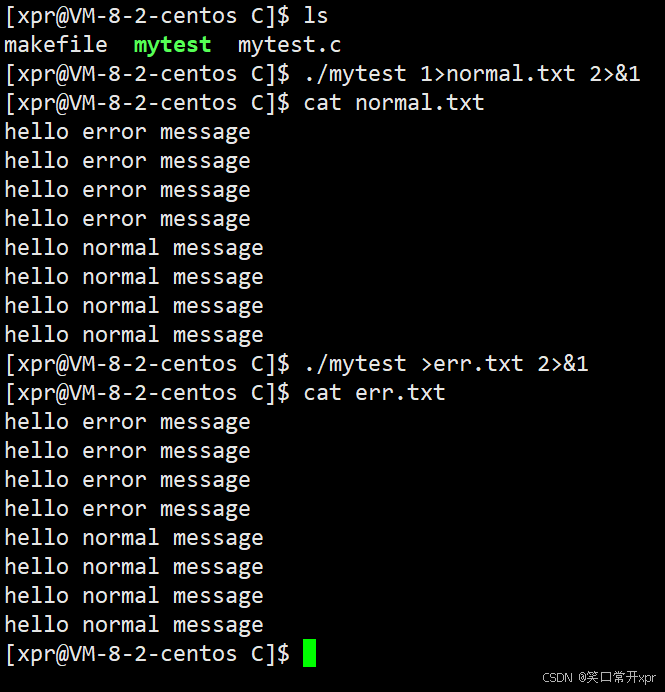
?????????1 可 以 省 略 不 寫。stdout 和 stderr 可 以 重 定 向 到 1 個 文 件 中。
?????????./mytest >err.txt 2>&1 先 表 示 把 1 號 文 件 描 述 符 的 內 容 寫 入 err.txt 中,然 后 2>&1 表 示 把 2 號 文 件 描 述 符 中 的 內 容 寫 入 1 號 文 件 描 述 符 中。
fprintf
?????????將 字 符 寫 入 文 件 或 使 用 流。
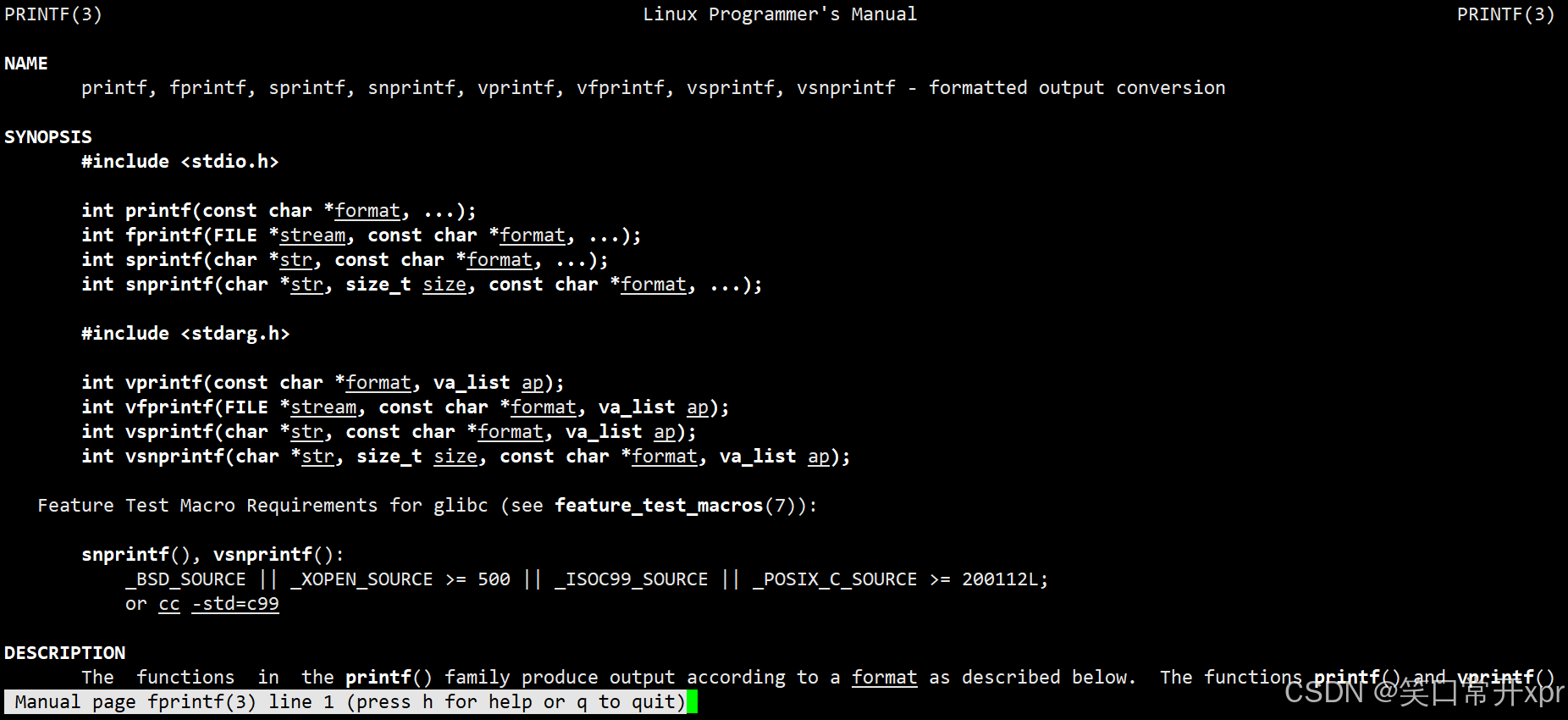
#include<stdio.h>
#include<unistd.h>
#include<string.h>
int main()
{printf("pid:%d\n",getpid());//打開文件的路徑和文件名,默認在當前路徑下創建一個文件FILE* pf = fopen("test.txt","a");if(pf == NULL){perror("fopen fail");return 1;}const char* str = "hello linux";fprintf(stdout,"%s,%d\n",str,1234);fclose(pf);return 0;
}
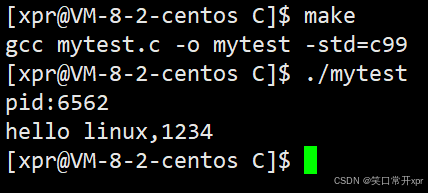
4、基 礎 知 識
?????????文 件 其 實 是 在 磁 盤 上 的,磁 盤 是 外 部 設 備,訪 問 文 件 其 實 是 訪 問 硬 件。操 作 系 統 是 硬 件 的 管 理 者。幾 乎 所 有 的 庫 只 要 是 訪 問 硬 件 設 備,必 定 要 封 裝 系 統 調 用。
(1)open
?????????打 開 或 者 創 建 文 件 或 者 設 備,可 以 指 定 文 件 的 權 限,即 文 件 是 否 存 在。
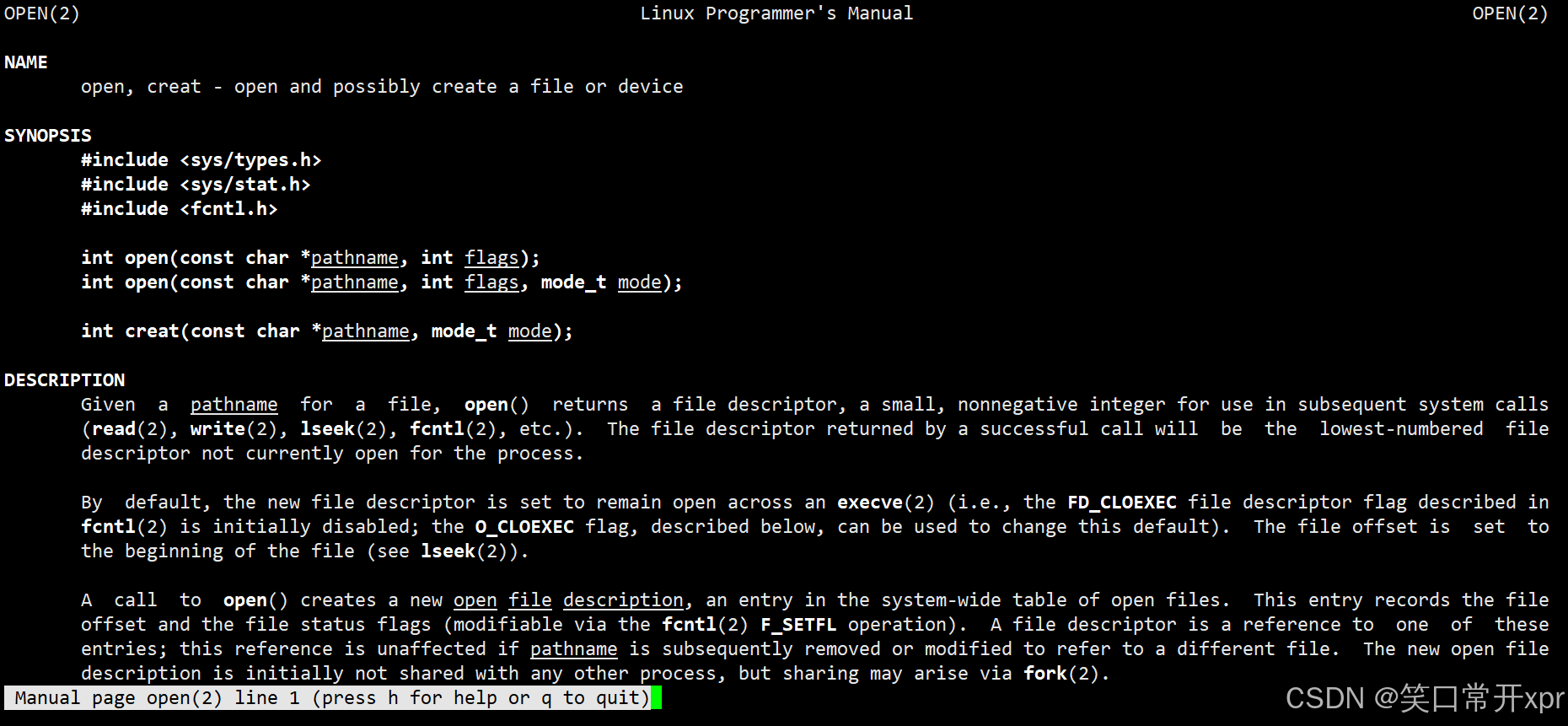
flags

#include<stdio.h>
#include<unistd.h>
#include<string.h>
#include<sys/types.h>
#include<sys/stat.h>
#include<fcntl.h>
int main()
{ umask(0); // 文件掩碼int fd = open("log.txt",O_WRONLY|O_CREAT,0666);if(fd<0){printf("open fail\n");return 1;}return 0;
}

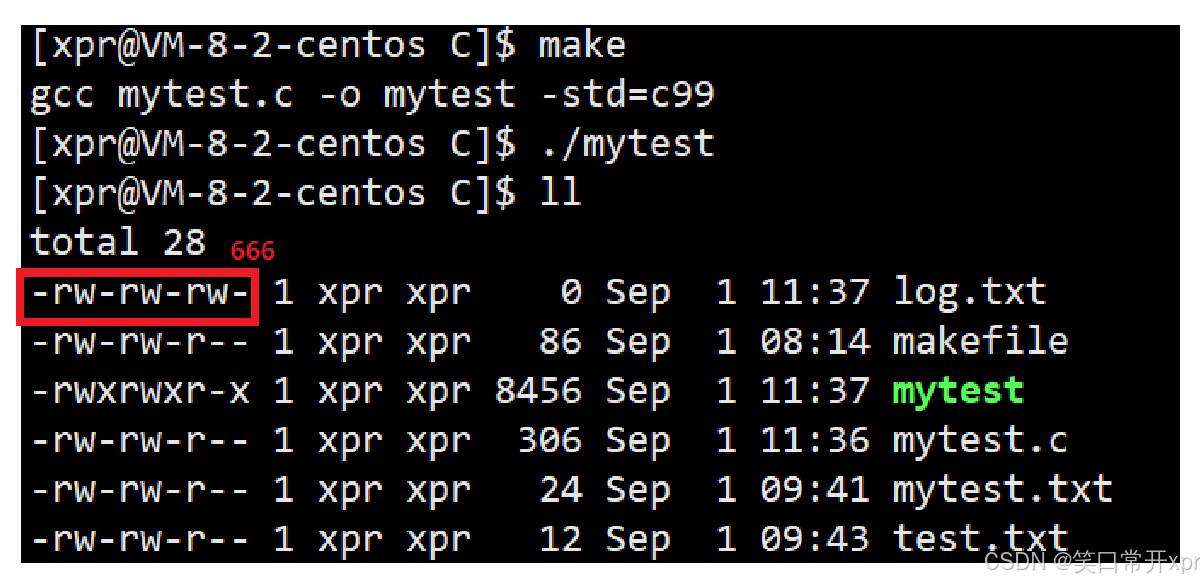
(2)close
關 閉 文 件
文 件 描 述 符
file descriptor:文 件 描 述 符,是 int 類 型。
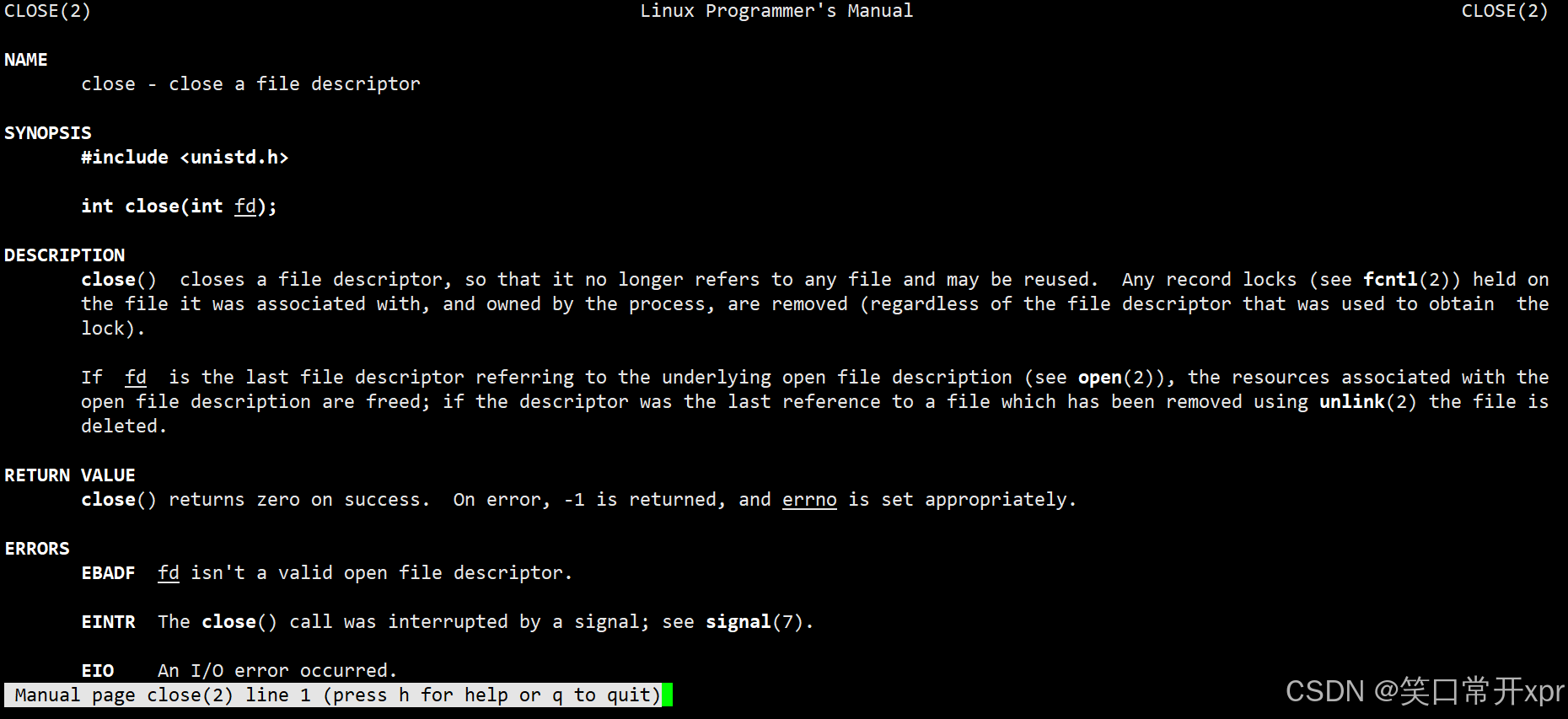
#include<stdio.h>
#include<unistd.h>
#include<string.h>
#include<sys/types.h>
#include<sys/stat.h>
#include<fcntl.h>
int main()
{ umask(0); // 文件掩碼int fd = open("log.txt",O_WRONLY|O_CREAT,0666);if(fd<0){printf("open fail\n");return 1;}close(fd);return 0;
}
(3)write
?????????向 文 件 中 寫 入 文 件 描 述 符,返 回 值 是 實 際 寫 入 的 字 節 數。默 認 從 文 件 的 開 始 處 寫,不 會 對 文 件 清 空,讓 新 增 加 的 字 符 替 換 掉 舊 的 字 符。
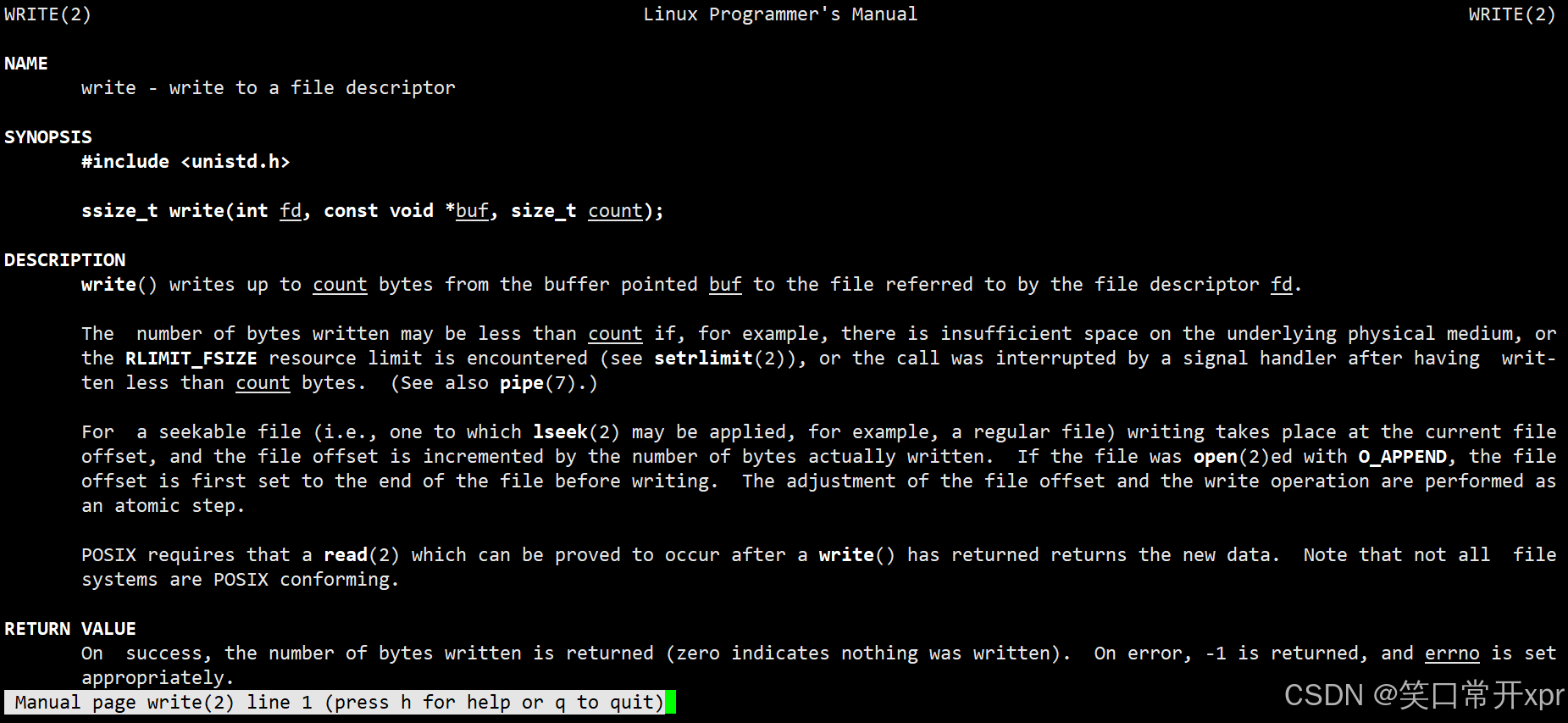
#include<stdio.h>
#include<unistd.h>
#include<string.h>
#include<sys/types.h>
#include<sys/stat.h>
#include<fcntl.h>
int main()
{ umask(0); // 文件掩碼int fd = open("log.txt",O_WRONLY|O_CREAT,0666);if(fd<0){printf("open fail\n");return 1;}const char* str = "hello world";write(fd,str,strlen(str));close(fd);return 0;
}
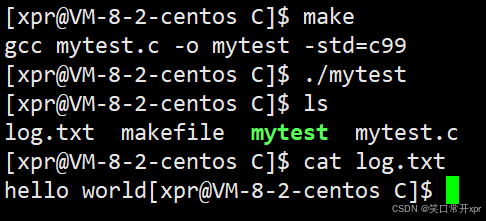
(4)標 志 位 傳 遞 方 式
1 個 整 數 可 以 傳 遞 1 個 標 志 位。
#include<stdio.h>
#include<unistd.h>
#include<string.h>
#define ONE (1 << 0) //1
#define TWO (1 << 1) //2
#define THREE (1 << 2)//4
#define FOUR (1 << 3) //8
void show(int flags)
{if(flags&ONE){printf("hello function1\n");}if(flags&TWO){printf("hello function2\n");}if(flags&THREE){printf("hello function3\n");}if(flags&FOUR){printf("hello function4\n");}
}
int main()
{ show(ONE);printf("-----------\n");show(ONE|TWO);printf("-----------\n");show(ONE|TWO|THREE);printf("-----------\n");return 0;
}

二、訪 問 文 件 的 本 質
1、struct file
?????????操 作 系 統 內 描 述 一 個 被 打 開 文 件 的 信 息。
直 接 或 者 間 接 包 含 以 下 屬 性:
- 被 打 開 的 文 件 在 哪 個 位 置
- 基 本 屬 性、權 限、大 小、讀 寫 位 置、誰 打 開 的。
- 文 件 的 內 核 緩 沖 區 信 息
- struct file *next 指 針。
?????????對 文 件 的 操 作 改 為 對 雙 向 鏈 表 的 增 刪 查 改。
?????????一 個 進 程 可 以 打 開 多 個 文 件,要 建 立 進 程 PCB 和 打 開 文 件 的 關 系。

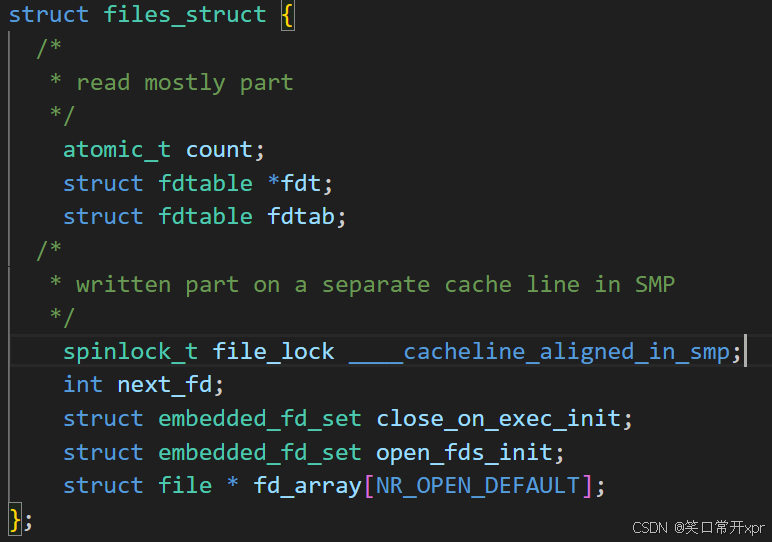
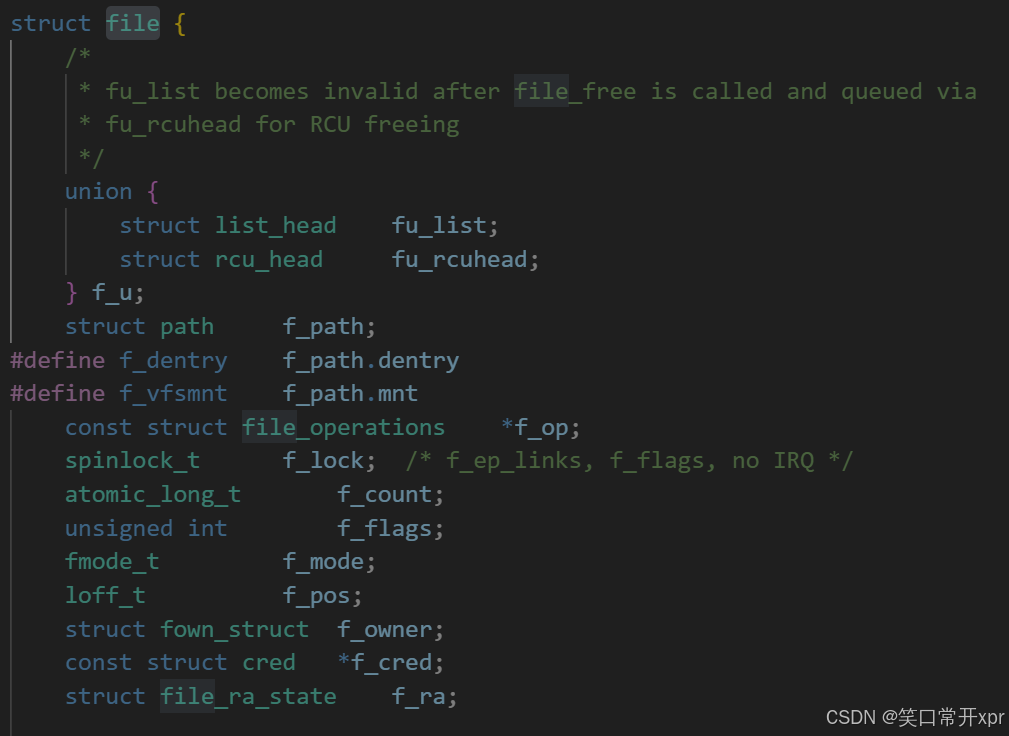
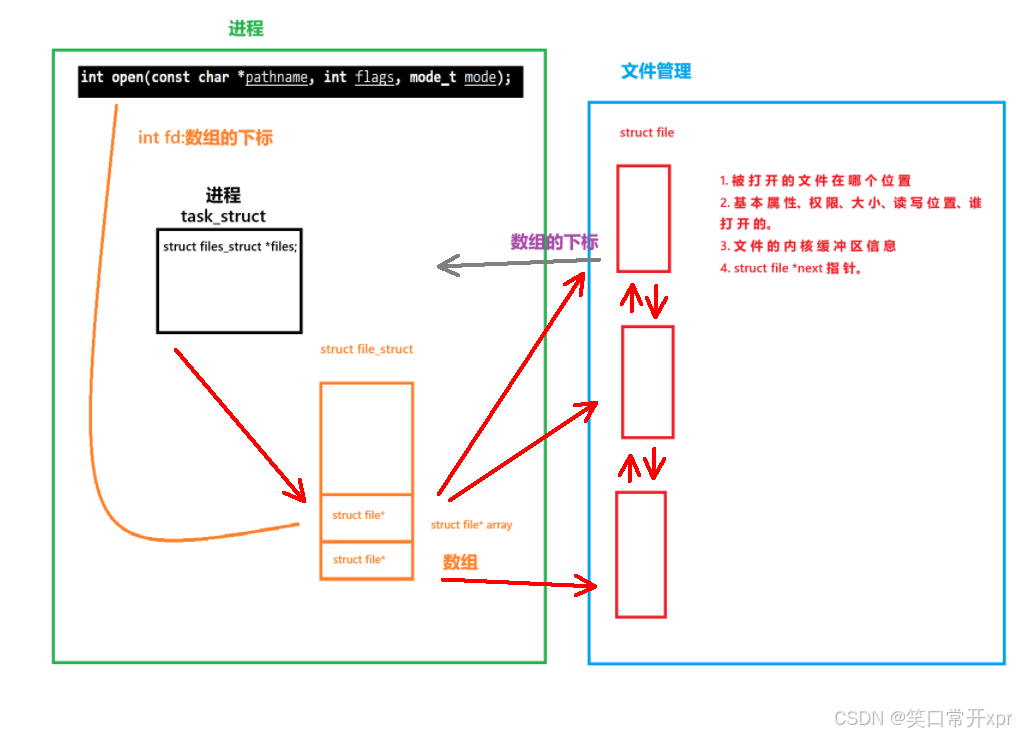
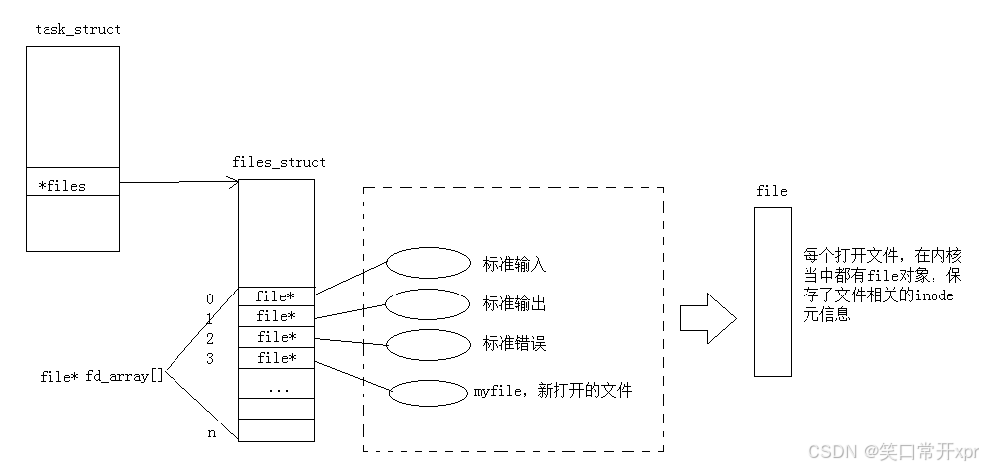
2、FILE
?????????C 語 言 中 的 FILE 是 C 庫 中 自 己 封 裝 的 結 構 體,里 面 包 含 文 件 描 述 符。
#include<stdio.h>
#include<unistd.h>
#include<string.h>
#include<sys/types.h>
#include<sys/stat.h>
#include<fcntl.h>
int main()
{ printf("stdin->fd:%d\n",stdin->_fileno);printf("stdout->fd:%d\n",stdout->_fileno);printf("stderr->fd:%d\n",stderr->_fileno);return 0;
}
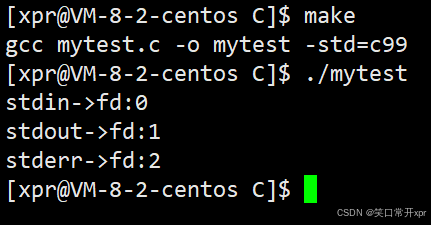
3、close(1)
printf
?????????可 以 使 用 close(1); 關 閉 顯 示 器 使 printf 無 法 顯 示 在 顯 示 屏 上。說 明 printf 的 底 層 使 用 了 1 號 文 件 描 述 符。
#include<stdio.h>
#include<unistd.h>
#include<string.h>
#include<sys/types.h>
#include<sys/stat.h>
#include<fcntl.h>
int main()
{ close(1);printf("stdin->fd:%d\n",stdin->_fileno);printf("stdout->fd:%d\n",stdout->_fileno);printf("stderr->fd:%d\n",stderr->_fileno);return 0;
}

fprintf
#include<stdio.h>
#include<unistd.h>
#include<string.h>
#include<sys/types.h>
#include<sys/stat.h>
#include<fcntl.h>
int main()
{ close(1);int ret = printf("stdin->fd:%d\n",stdin->_fileno);printf("stdout->fd:%d\n",stdout->_fileno);printf("stderr->fd:%d\n",stderr->_fileno);fprintf(stderr,"printf ret:%d\n",ret);return 0;
}
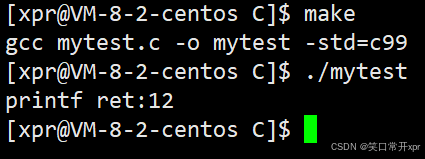
?????????如 果 關 閉 了 1 號 文 件 描 述 符,使 用 2 號 文 件 描 述 符 也 可 以 在 顯 示 器 上 輸 出。
4、fd
#include<stdio.h>
#include<unistd.h>
#include<string.h>
#include<sys/types.h>
#include<sys/stat.h>
#include<fcntl.h>
int main()
{ umask(0); // 文件掩碼int fd1 = open("log.txt",O_WRONLY|O_CREAT,0666);int fd2 = open("log.txt",O_WRONLY|O_CREAT,0666);int fd3 = open("log.txt",O_WRONLY|O_CREAT,0666);int fd4 = open("log.txt",O_WRONLY|O_CREAT,0666);printf("fd1:%d\n",fd1);printf("fd2:%d\n",fd2);printf("fd3:%d\n",fd3);printf("fd4:%d\n",fd4);close(fd1);close(fd2);close(fd3);close(fd4);return 0;
}

?????????返 回 的 整 數 值 都 是 數 組 的 下 標 且 都 是 整 數,返 回 的 整 數 值 都 是 從 3 開 始 的。0 是 stdin(鍵 盤 文 件),1 是 stdout(顯 示 器 文 件),2 是 stderr(顯 示 器 文 件)。
驗 證
#include<stdio.h>
#include<unistd.h>
#include<string.h>
#include<sys/types.h>
#include<sys/stat.h>
#include<fcntl.h>
int main()
{ const char* str = "hello linux";write(1,str,strlen(str));write(2,str,strlen(str));return 0;
}

5、read
?????????從 文 件 描 述 符 中 讀 取。
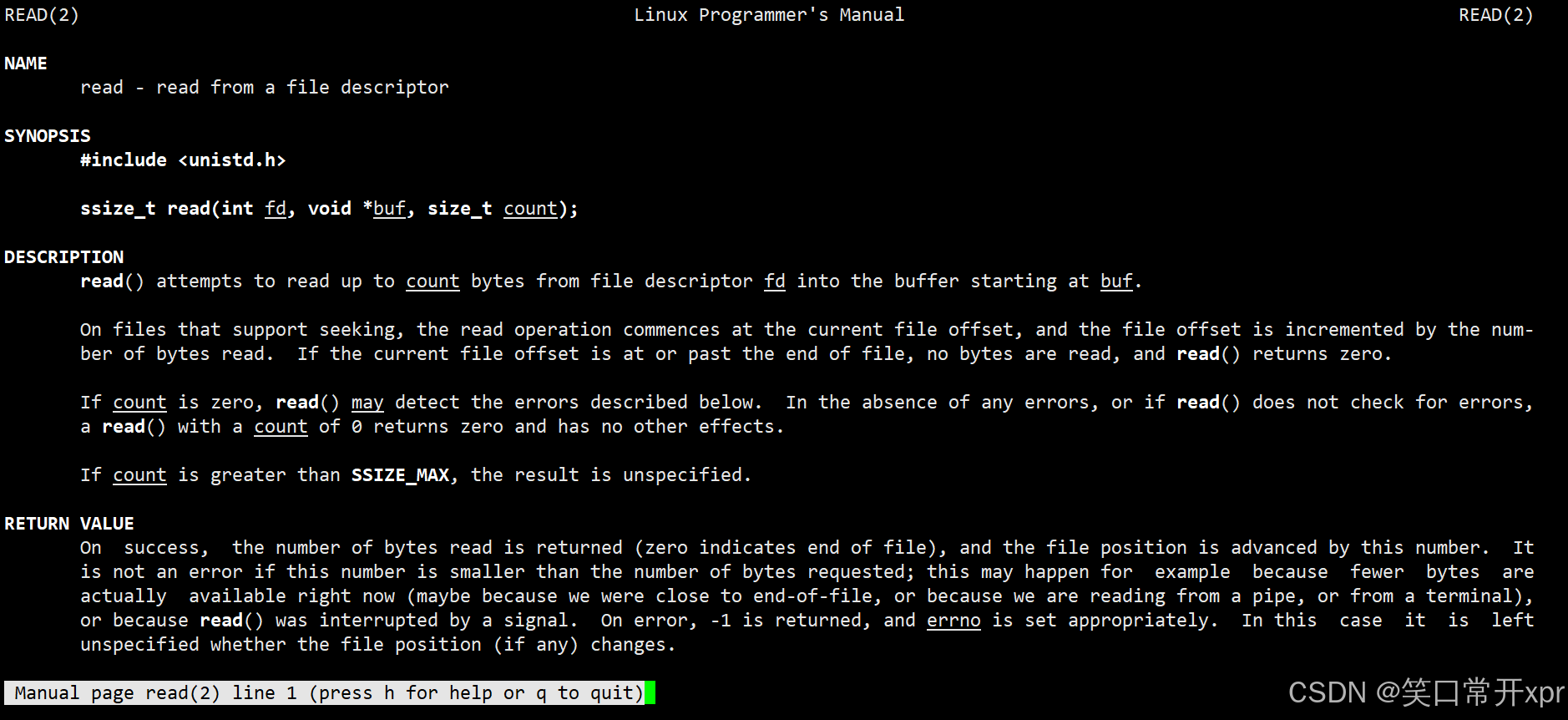
#include<stdio.h>
#include<unistd.h>
#include<string.h>
#include<sys/types.h>
#include<sys/stat.h>
#include<fcntl.h>
int main()
{ char buf[100];ssize_t count = read(0,buf,sizeof(buf));if(count < 0){return 1;}buf[count] = '\0';printf("%s\n",buf);return 0;
}
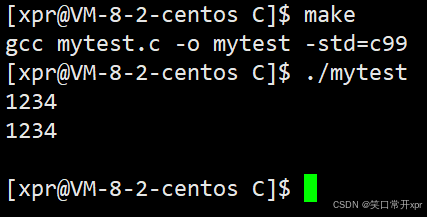
6、引 用 計 數 與 關 閉 文 件
引 用 計 數
?????????關 閉 文 件 時,使 用 close 時,對 1 號 描 述 符 的 引 用 計 數 減 1,然 后 將 1 號 指 針 位 置 置 空 即 可,然 后 判 斷 引 用 計 數 是 否 為 0,如 果 為 0,則 說 明 沒 有 文 件 被 使 用,系 統 會 回 收 struct 對 象。如 果 不 為 0,則 說 明 還 有 文 件 被 使 用。
三、重 定 向
1、文 件 描 述 符 的 分 配 規 則
(1)原 版 代 碼
#include<stdio.h>
#include<unistd.h>
#include<string.h>
#include<sys/types.h>
#include<sys/stat.h>
#include<fcntl.h>
#define filename "log.txt"
int main()
{ int fd = open(filename,O_CREAT|O_WRONLY|O_TRUNC,0666);if(fd < 0){perror("open fail");return 1;}printf("fd:%d\n",fd);const char* str = "hello world\n";int cnt = 5;while(cnt){write(fd,str,strlen(str));cnt--;}close(fd);return 0;
}
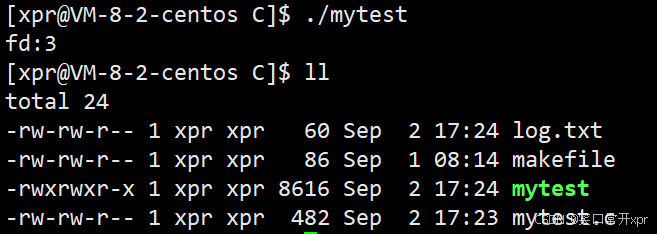
?????????此 時 文 件 描 述 符 為 3,log.txt 所 對 應 的 文 件 權 限 為 664。
(2)close(0)
在 代 碼 最 前 面 添 加 close(0),輸 出 的 文 件 描 述 符 為 0。

(3)close(1)
在 代 碼 最 前 面 添 加 close(1)
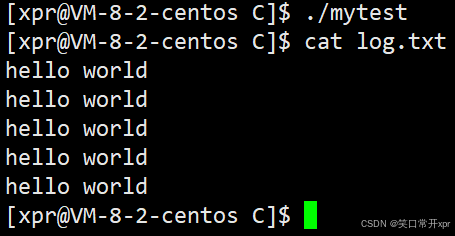
?????????因 為 printf 的 底 層 使 用 了 stdout,stdout 的 文 件 描 述 符 為 1,這 里 將 1 關 閉,無 法 在 顯 示 器 上 輸 出。
(4)close(2)
在 代 碼 最 前 面 添 加 close(2)
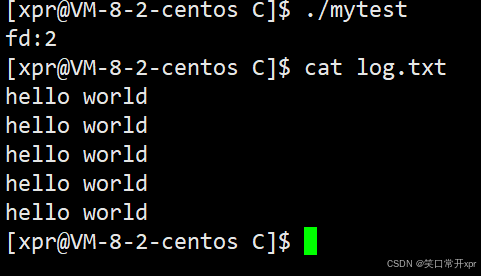
關 閉 2 號 文 件 描 述 符 后,輸 出 的 文 件 描 述 符 為 2。
(5)總 結
?????????關 閉 幾 號 文 件 描 述 符,文 件 描 述 符 就 輸 出 幾 號,說 明 文 件 描 述 符 對 應 的 分 配 規 則 是 從 0 下 標 開 始,尋 找 最 小 的 沒 有 使 用 的 數 組 位 置,它 的 下 標 就 是 新 文 件 的 文 件 描 述 符。
2、重 定 向 的 原 理
#include<stdio.h>
#include<unistd.h>
#include<string.h>
#include<sys/types.h>
#include<sys/stat.h>
#include<fcntl.h>
#define filename "log.txt"
int main()
{ close(1);int fd = open(filename,O_CREAT|O_WRONLY|O_TRUNC,0666);if(fd < 0){perror("open fail");return 1;}const char* str = "hello world\n";int cnt = 5;while(cnt){write(1,str,strlen(str));cnt--;}close(fd);return 0;
}
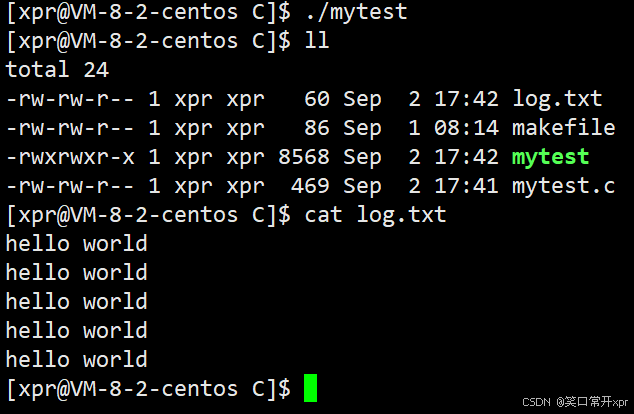
?????????關 閉 1 號 文 件 描 述 符 后,結 果 沒 有 在 顯 示 器 中 顯 示,卻 寫 入 了 文 件 中。
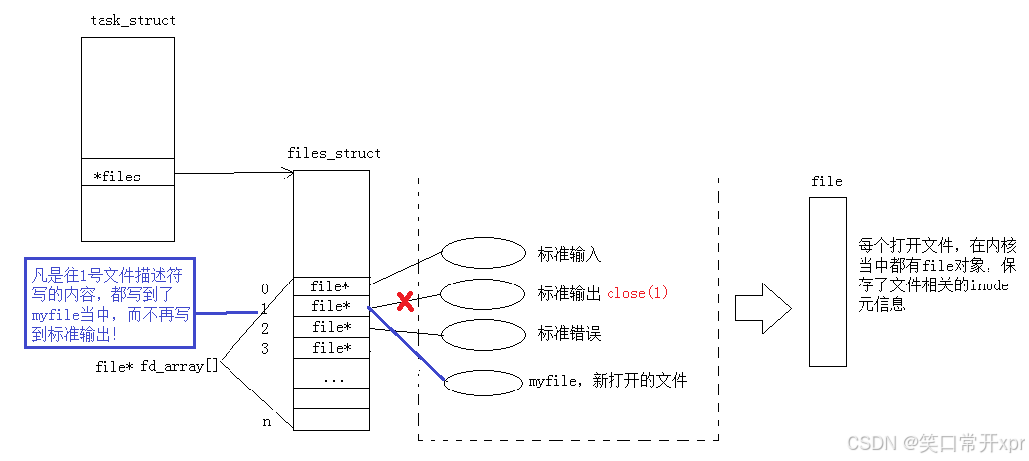
?????????關 閉 1 號 文 件 描 述 符 后,此 時 打 開 文 件,文 件 原 來 應 該 指 向 3 號 文 件 描 述 符,現 在 被 改 成 了 1 號 文 件 描 述 符,此 時 發 生 了 輸 入 重 定 向。
?????????重 定 向 的 本 質 是 對 數 組 下 標 的 內 容 進 行 了 修 改。如 果 想 要 發 生 重 定 向 需 要 將 原 來 文 件 描 述 符 中 的 內 容 關 閉 或 者 覆 蓋 掉 即可。
3、dup2
?????????拷 貝 文 件 描 述 符 的 指 針 內 容,將 新 的 文 件 描 述 符 的 內 容 拷 貝 給 舊 的 文 件 描 述 符,然 后 關 閉 新 的 文 件 描 述 符。

4、輸 入 重 定 向
#include<stdio.h>
#include<unistd.h>
#include<string.h>
#include<sys/types.h>
#include<sys/stat.h>
#include<fcntl.h>
#define filename "log.txt"
int main()
{ int fd = open(filename,O_CREAT|O_WRONLY|O_TRUNC,0666);if(fd < 0){perror("open fail");return 1;}//重定向dup2(fd,1);close(fd);const char* str = "hello world\n";int cnt = 5;while(cnt){write(1,str,strlen(str));cnt--;}close(fd);return 0;
}
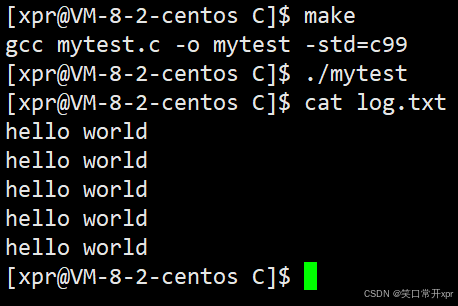
?????????原 來 1 號 文 件 描 述 符 可 以 將 內 容 輸 出 到 顯 示 器 中,重 定 向 以 后 顯 示 器 無 法 輸 出 內 容,輸 出 的 是 文 件 的 內 容。
5、追 加 重 定 向
將 write 中 的 O_TRUNC 改 成 O_APPEND 即 可 實 現 追 加 重 定 向。
#include<stdio.h>
#include<unistd.h>
#include<string.h>
#include<sys/types.h>
#include<sys/stat.h>
#include<fcntl.h>
#define filename "log.txt"
int main()
{ int fd = open(filename,O_CREAT|O_WRONLY|O_APPEND,0666);if(fd < 0){perror("open fail");return 1;}//重定向dup2(fd,1);close(fd);const char* str = "hello world\n";int cnt = 5;while(cnt){write(1,str,strlen(str));cnt--;}close(fd);return 0;
}
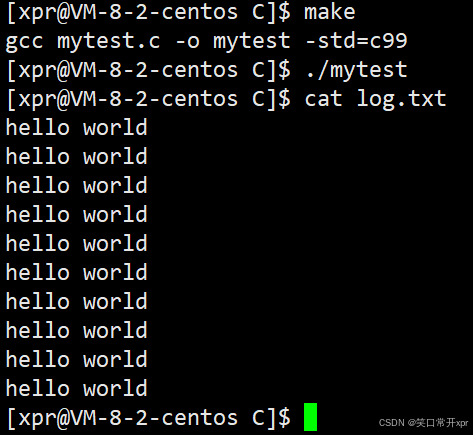
6、輸 入 重 定 向
#include<stdio.h>
#include<unistd.h>
#include<string.h>
#include<sys/types.h>
#include<sys/stat.h>
#include<fcntl.h>
#define filename "log.txt"
int main()
{int fd = open(filename,O_RDONLY);if(fd < 0){perror("open");return 1;}dup2(fd,0);//從標準輸入讀取改為從文件中讀取char buf[1024];ssize_t s = read(0,buf,sizeof(buf)-1);if(s>0){buf[s]='\0';printf("echo:%s\n",buf);}return 0;
}
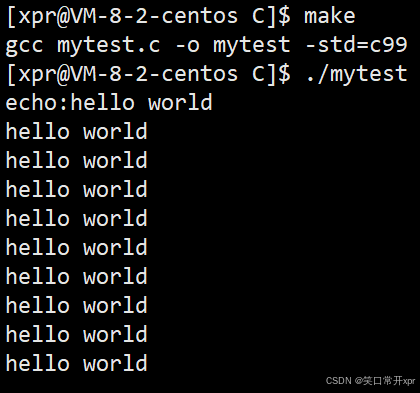
cat 的 輸 入 重 定 向
從 文 件 中 讀 取 改 為 從 鍵 盤 中 讀 取。
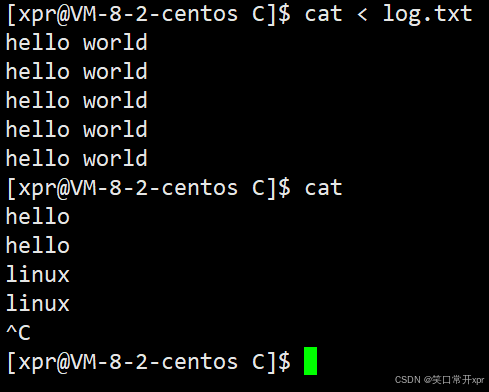
7、printf 與 fprintf
?????????printf 和 fprintf 用 的 都 是 stdin,可 以 修 改 文 件 描 述 符,改 變 輸 出 的 位 置。
#include<stdio.h>
#include<unistd.h>
#include<string.h>
#include<sys/types.h>
#include<sys/stat.h>
#include<fcntl.h>
#define filename "log.txt"
int main()
{ int fd = open(filename,O_CREAT|O_WRONLY|O_APPEND,0666);if(fd < 0){perror("open fail");return 1;}//重定向dup2(fd,1);printf("fd:%d\n",fd);printf("hello printf\n");fprintf(stdout,"hello fprintf\n");close(fd);return 0;
}
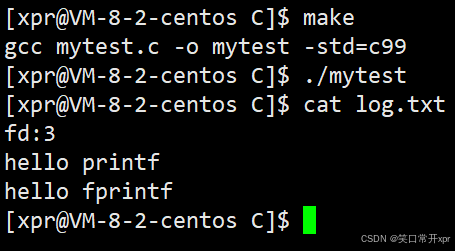
如 何 理 解 “linux 中 一 切 皆 文 件”
?????????所 有 操 作 計 算 機 的 動 作 都 是 以 進 程 的 形 式 操 作 的,所 有 訪 問 文 件 的 操 作 都 是 用 進 程 的 方 式 訪 問 文 件 的。

四、總 結
?????????本 文 已 幫 你 掌 握 Linux 文 件 操 作 核 心:文 件 定 義、文 件 描 述 符、重 定 向 本 質,及 C 庫 與 系 統 調 用 的 關 系,也 理 解 了 “一 切 皆 文 件” 的 設 計。這 些 知 識 是 后 續 進 程 通 信、網 絡 編 程 的 基 礎。建 議 動 手 修 改 代 碼 加 深 理 解,關 注 專 欄 Linux 探 索 之 旅:從 命 令 行 到 系 統 內 核,后 續 將 解 鎖 更 多 進 階 內 容,幫 你 搭 建 系 統 編 程 知 識 體 系。






 在Window 系統的默認安裝配置)


,js(基本類型、運算符典例))
)

)


)



![[Godot入門大全]目錄](http://pic.xiahunao.cn/[Godot入門大全]目錄)